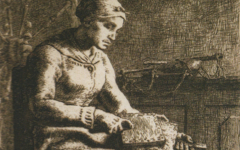Millet’s The Angelus (1857-9) and other works
Jean-François Millet’s images of rural France romanticized the hard lives of the peasants working the fields as though they were biblical figures toiling away at a sacred task. An early biography of Millet, published in 1881, conflated Millet’s rôle as an artist with that of a religious figure and described Millet himself as “a labourer” and the field as “his art.”1 And that, in essence, is what we see. Long before Robert Smithson moved massive boulders to create the Spiral Jetty in the 1970’s, Millet had already used the land as his canvas. Millet even referred to art as ‘a complex of wheels in which one is crushed’ thereby linking repetitive, mechanical labor with his own life. His art then, like that of so many other of his predecessors, depicts the process of making art within his own mind. Besides Millet never thought of himself as an illustrator but as a poet on a spiritual mission for whom making art was hard labor.
In The Angelus two peasants pray as the church in the background tolls its bells at twilight, that moment when Catholics remember the Annunciation and God's mystical insemination of the Virgin. Thus Millet’s figures pause in prayer much as an icon-painter would pray before picking up his brush. The couple, both genders representing the androgyny of the creative mind, contemplate a moment of divine creation just as Millet the artist, through spiritual reflection, conceived this painting, also at a moment of divine insemination.
Click next thumbnail to continue
In another well-known image, The Sower, Millet's alter ego can be seen taking ‘paint’ from his ‘palette’ to sow it on the land, the artist's "canvas" and God's too.
Click next thumbnail to continue
The Man with a Hoe, contemporaneous with Manet's Olympia, should really be described as The Artist with his Paint-Hoe pausing from the back-breaking work of painting this canvas.
St. Augustine in the fifth century also described his mind and body as "soil" that he needed to work on in order to perfect his self.2 Millet, it now seems, used the same metaphor to express on canvas the hard internal labor required to make a masterpiece as well as that mystical moment during which the artist's mind becomes at one with God's and his own Immaculate Conception is conceived.
More Works by Millet
Notes:
1. Alfred Sensier's biography cited in Van Gogh’s Imaginary Museum: Exploring the Artist’s Inner World (Amsterdam: The Van Gogh Museum) 2003, p. 72
2. Paul Jay, Being in the Text: Self-Representation from Wordsworth to Roland Barthes (Ithaca: Cornell University Press) 1984, p. 30
Original Publication Date on EPPH: 10 Mar 2012. | Updated: 0. © Simon Abrahams. Articles on this site are the copyright of Simon Abrahams. To use copyrighted material in print or other media for purposes beyond 'fair use', you must obtain permission from the copyright owner. Websites may link to this page without permission (please do) but may not reproduce the material on their own site without crediting Simon Abrahams and EPPH.




